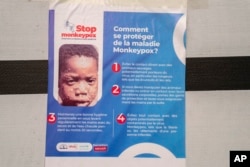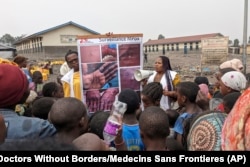london —
The World Health Organization declared Wednesday that the increasing spread of mpox in Africa is a global health emergency, warning the virus might ultimately spill across international borders.
The announcement by WHO director-general Tedros Adhanom Ghebreyesus came after a meeting of the United Nation health agency’s emergency committee. The Africa Centers for Disease Control and Prevention declared mpox a public health emergency on the continent on Tuesday.
The WHO said there have been more than 14,000 cases and 524 deaths in Africa this year, which already exceeds last year’s figures.
So far, more than 96% of all cases and deaths are in a single country — Congo. Scientists are concerned by the spread of a new version of the disease there that might be more easily transmitted among people.
Here’s a look at what we know about mpox, and what might be done to contain it:
What is mpox?
Mpox, also known as monkeypox, was first identified by scientists in 1958 when there were outbreaks of a “pox-like” disease in monkeys. Until recently, most human cases were seen in people in central and West Africa who had close contact with infected animals.
In 2022, the virus was confirmed to spread via sex for the first time and triggered outbreaks in more than 70 countries across the world that had not previously reported mpox.
Mpox belongs to the same family of viruses as smallpox but causes milder symptoms such as fever, chills and body aches. People with more serious cases can develop lesions on the face, hands, chest and genitals.
What’s happening in Africa that’s causing all this concern?
The number of cases has jumped dramatically. Last week, the Africa CDC reported that mpox has now been detected in at least 13 African countries. Compared with the same period last year, the agency said cases are up 160% and deaths have increased by 19%.
Earlier this year, scientists reported the emergence in a Congolese mining town of a new form of mpox that can kill up to 10% of people and may spread more easily.
Unlike in previous mpox outbreaks, where lesions were mostly seen on the chest, hands and feet, the new form of mpox causes milder symptoms and lesions on the genitals.
That makes it harder to spot, meaning people might also sicken others without knowing they’re infected, said Dr. Placide Mbala-Kingebeni, a Congolese researcher who led the research into the new form of mpox.
WHO said mpox was recently identified for the first time in four East African countries: Burundi, Kenya, Rwanda and Uganda. All of those outbreaks were linked to the epidemic in Congo. Tedros said there was concern for the further spread of the disease within Africa and beyond.
In the Ivory Coast and South Africa, health authorities have reported outbreaks of a different and less dangerous version of mpox that spread worldwide in 2022 and infected nearly 100,000 people.
What’s the threat to the rest of the world?
Like any infectious disease, the new form of mpox seen in Congo could cross borders — cases have already been detected in four other East African countries.
On Thursday, Sweden’s public health agency said it identified the first case of the new mpox variant in someone who had recently been in Africa, and who sought health care in Stockholm.
Officials said the risk to the general public was considered “very low” and that they expect sporadic imported cases to continue.
Kamituga, the region in Congo where the new form of mpox was first spotted, is home to a significant transient population traveling through Africa and beyond.
Still, given the resources in rich countries to stop mpox, scientists suspect that if new outbreaks linked to Congo were to be identified, transmission could be stopped relatively quickly.
Unlike COVID-19 or measles, mpox is not airborne and typically requires close, skin-to-skin contact to spread.
What does an emergency declaration mean?
WHO’s emergency declaration is meant to spur donor agencies and countries into action. But the global response to previous declarations has been mixed.
Africa CDC Director General Dr. Jean Kaseya said the agency’s declaration of a public health emergency was meant “to mobilize our institutions, our collective will and our resources to act swiftly and decisively.” He appealed to Africa’s international partners for help, saying that the escalating caseload in Africa had largely been ignored.
Dr. Boghuma Titanji, an infectious diseases expert at Emory University, said the last WHO emergency declaration for mpox “did very little to move the needle” on getting things like diagnostic tests, medicines and vaccines to Africa.
How does the current outbreak in Africa compare to the 2022 epidemic?
During the global outbreak of mpox in 2022, gay and bisexual men made up the vast majority of cases and the virus was mostly spread through close contact, including sex.
Although some similar patterns have been seen in Africa, children under 15 now account for more than 70% of the mpox cases and 85% of deaths in Congo.
Greg Ramm, Save the Children’s Congo director, said the organization was particularly worried about the spread of mpox in the crowded camps for refugees in the east, noting there were 345,000 children “crammed into tents in unsanitary conditions.” He said the country’s health system was already “collapsing” under the strain of malnutrition, measles and cholera.
Emory’s Titanji said it was unclear why children were so disproportionately hit by mpox in Congo. She said it might be because kids are more susceptible to the virus or that social factors, like overcrowding and exposure to parents who caught the disease, might explain it.
How might mpox be stopped?
The 2022 outbreak of mpox in dozens of countries was largely shut down with the use of vaccines and treatments in rich countries, in addition to convincing people to avoid risky behavior. But barely any vaccines or treatments have been available in Africa.
Marks, of the London School of Hygiene and Tropical Medicine, said that immunization would likely help — including inoculating people against smallpox, a related virus.
“We need a large supply of vaccine so that we can vaccinate populations most at risk,” he said, adding that would mean sex workers, children and adults living in outbreak regions.
Congolese authorities have asked for 4 million doses mostly for young children, but no doses have yet been received, said Cris Kacita Osako, coordinator of Congo’s Monkeypox Response Committee.
Source: voanews.com





